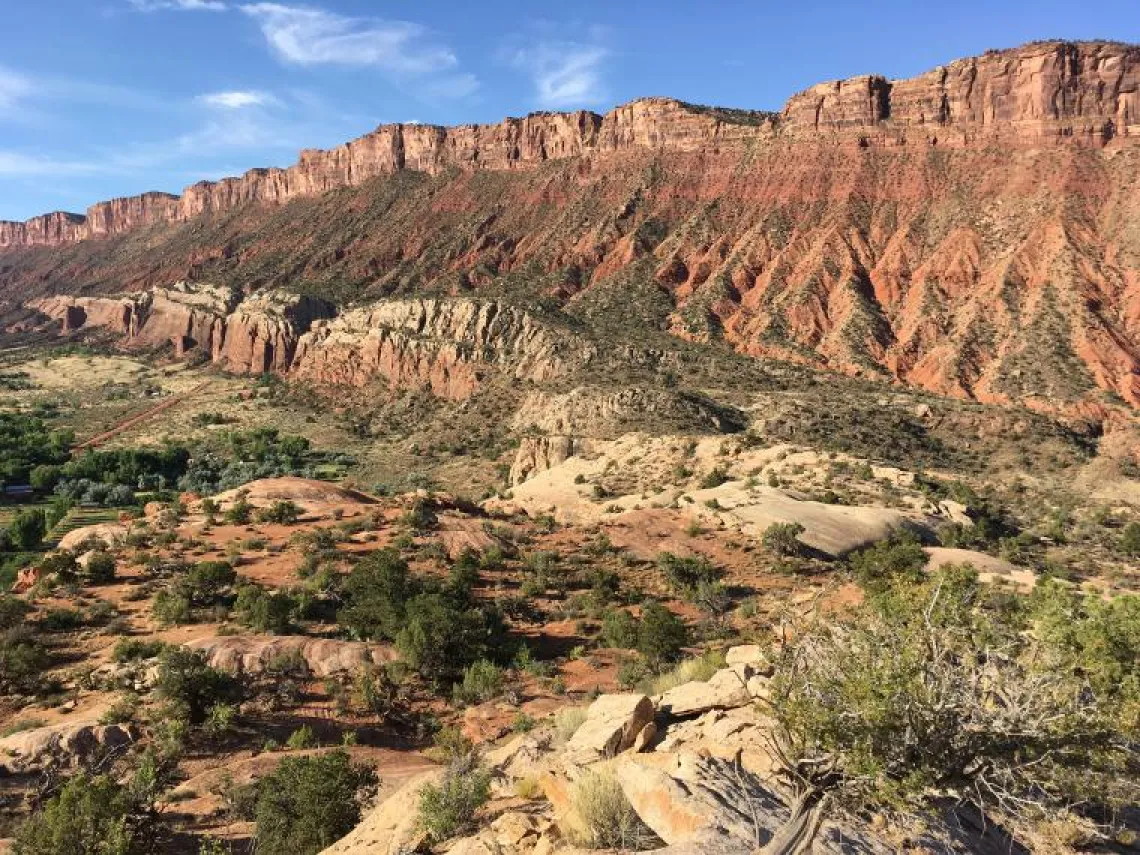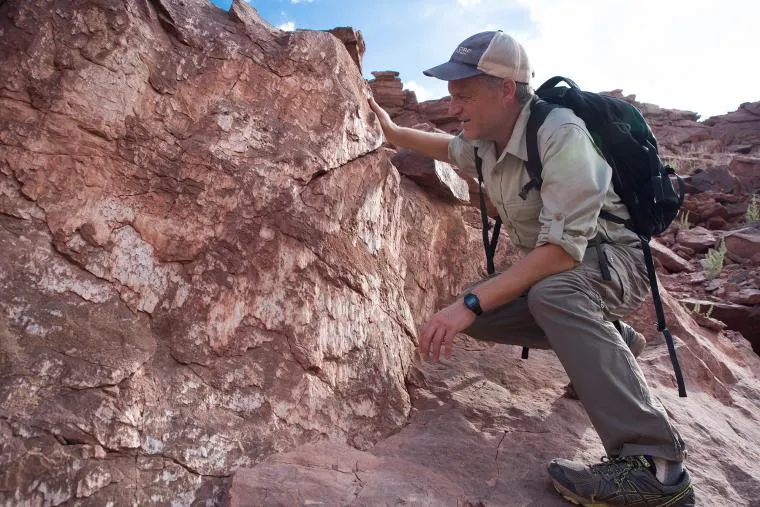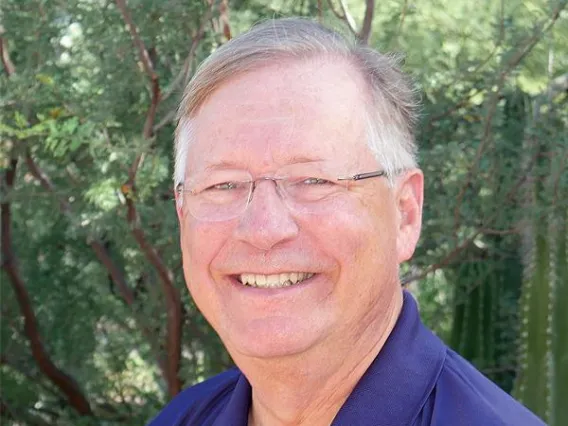An old East Indian parable tells of a group of blind men using touch to describe an elephant, which they have never encountered before. Each feels only one part of the animal—a leg, the trunk, the tail—and believes it’s an entirely different animal from what the others describe based on what they feel. The story speaks to the idea that while each man’s perception was valid, they needed to share their knowledge for a complete, accurate picture of the animal.
For a group of University of Arizona researchers and two New Mexico Institute of Technology scientists, their “elephant” for the last three years has been the vast and ancient Paradox Basin that straddles primarily the Utah and Colorado border, but includes slivers of Arizona and New Mexico. The aim is to integrate the knowledge gleaned by several scientific specialties to understand the feature’s formation.
A better awareness of a region’s fluid-rock system can lead to better ways of finding and producing mineral deposits, as well as protecting environmental resources. New ways to sequester carbon dioxide and store spent nuclear fuel could be discovered. Recognizing the fluid-rock systems of other planets would inform exploration of mineral resources for commercialization.

Permian White Rim/Cutler sandstone bleached by migrating reduced fluids, overlain by Moenkopi and Chinle Formations and Wingate Sandstone, Castle Valley.
Keck Foundation finances Paradox Basin study
The “Evolution of Crustal Paleofluid Flow Systems” project has been funded by a $1 million W.M. Keck Foundation grant and a few hundred-thousand dollars granted to individual participants. The work is creating a clearer picture on how prehistoric fluids—or paleofluids—have influenced rock and mineral formations.
In the project’s latest progress report, researchers
- used two- and three-dimensional models to map out the history of subsurface fluids and the evolution of the basin
- further refined the idea that early flow of one type of fluid is needed to prepare rocks to trap metals and other minerals from a subsequent flow
- observed that different types of faults affect how quickly fluids are moved through subsurface rock
- identified opportunities to further develop dating methods for fluid-rock reaction products.
The project will extend an extra year for researchers to finish their work, partly because of disruptions caused by COVID-19.
Researchers seek the big picture of fluid-rock systems

PhD students Jihyun Kim and Rebecca Tyne sample
deep basinal brines for noble gas isotope analyses.
Typically, scientists in such divergent fields as geochemistry, hydrogeology, structural geology, geophysics, geochronology and basin modeling would take a look at a small part of a fluid-rock system, such as one type of fluid or a specific interaction between fluid and rock. “We were kind of looking at different parts of the elephant,” said Peter W. Reiners, a geosciences professor and associate dean of research in the UArizona College of Science. He is the project leader. A 2016 Paradox Basin field trip by colleagues that Reiners attended led to talks about working together. “We thought it would be cool to combine perspectives and understand this as one big elephant,” he said.
In their abstract for the Keck grant, Reiners and his team said this project would be the first time an integrative approach would be used to study subsurface fluid-rock systems. “Such insight is essential to describe, understand and predict the complex, dynamic and coupled processes that characterize subsurface fluid-rock systems,” according to the abstract. Paradox Basin was chosen because of its diverse geologic features, including different kinds of faults, ore deposits, fluids and sedimentary rocks. It’s about the size of Virginia, formed from over 300 million years of cyclical ocean flooding and river and dune deposits.
The project team of eight scientists and many student researchers have worked with partners in the groundwater, mining and oil and gas industries to gain access to basin features for study. They have traced over time the sources and paths of different types of fluids, including petroleum and natural gas, as well as fresh waters and brines, some of which deposited copper, uranium and vanadium. “We wanted to know where they came from, when they flowed through the rocks and how that relates to the geologic and climate history of the region,” Reiners said.
Greater understanding has applications for today

Peter Reiners inspects slickensides on the Moab Fault
Knowing how fluid-rock systems create and influence regional geological features is fascinating science in itself. But it also has real-world applications. “The flow of liquids is one of the most important things in both the scientific point of view and human-interaction point of view,” suggested Mark D. Barton, the co-director of the Lowell Institute for Mineral Resources. He’s also a geoscience professor and a co-principal investigator on the project. For instance, knowing where mineral deposits are in relation to groundwater flows will help configure current and future mining operations that protect drinking and irrigation water, Barton said. “My particular interest is essentially the physics and chemistry of these processes,” he said. “You need to be very sure you’re not going to contaminate groundwater around (a mine).”
Examining the terrain and its history also helps mining companies take advantage of opportunities for mineral development. Knowing how the fluid-rock system of an area works could provide surface signs of a mineral deposit. Coupling that knowledge with hyperspectral remote imaging would help in designing a pit mine for safety and efficiency. Reiners thinks this better understanding of fluid-rock systems can lead to effective designs and procedures to sequester into the subsurface carbon dioxide released from the burning of fossil fuels. Other aspects of the project might also reveal methods of safely storing spent nuclear fuel within a fluid-rock system.
Above all, the project is meant to demonstrate that a multi-specialty, integrated approach to big projects can yield meaningful results. Both Barton and Reiners admit that scientists tend to work with small groups of colleagues focusing on what they’re interested in. That’s not necessarily a bad thing. Grasping complex structures like a mountain range or a human circulatory system requires examining its parts. “A lot of science is sort of breaking things down because if you want to really understand them, you have to start at a basic level,” Reiners said. But an integrative approach may reveal more questions to pursue, as well as provide answers to existing inquiries. “There are times when you want to stand back,” he continued. “There are things that we see that are very important to recognize, but that we can only understand with a big perspective.”
Other articles in this series
Ancient Hydrology Informs Future Mining
Students trace the life of uranium, vanadium


